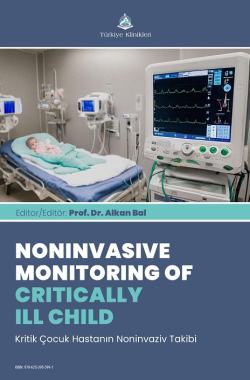NONINVASIVE BLOOD PRESSURE MONITORING IN CRITICALLY ILL CHILD
Selçuk Sinan Çelik1 Gülhan Atakul2 Hasan Ağin3
1Dr. Behçet Uz Pediatric Diseases and Surgery Training and Research Hospital, Department of Pediatric Intensive Care, İzmir, Türkiye
2Dr. Behçet Uz Pediatric Diseases and Surgery Training and Research Hospital, Department of Pediatric Intensive Care, İzmir, Türkiye
3Dr. Behçet Uz Pediatric Diseases and Surgery Training and Research Hospital, Department of Pediatric Intensive Care, İzmir, Türkiye
Çelik SS, Atakul G, Ağın H. Noninvasive Blood Pressure Monitoring in Critically Ill Child. In: Bal A, editor. Noninvasive Monitoring of Critically Ill Child. 1st ed. Ankara: Türkiye Klinikleri; 2025. p.101-105.
ABSTRACT
The main aim of monitoring of the critically ill paediatric patient is to recognise the problems, deter- mine the severity of the problems and guide the treatment by continuously monitoring the determined variables. Monitoring provides understanding of pathophysiology. Thus, it guides early diagnosis and treatment, reducing the risk of undesirable outcomes. It has been declared by many researchers that mortality and morbidity decrease and quality of patient care increases with monitoring.
Patient monitoring in intensive care can be done through inspection and manual recording of variables, or by using technological devices and systems. Monitoring can be roughly classified as invasive or noninvasive in terms of method. In the noninvasive method, monitoring such as ECG, pulsoximetry, capnography, blood pressure can be performed without requiring an intervention on the patient. Inva- sive methods, on the other hand, are performed by placing the equipment required for measurement in the body by performing an intervention on the patient – for example, arterial blood pressure measure- ment, pulmonary artery catheterisation, central venous pressure measurement.
Blood pressure monitoring is a parameter taken into account in determining the haemodynamic stabil- ity of the critically ill paediatric patient. Haemodynamic stability maintains homeostasis by ensuring that organ-tissue perfusion (cerebral, renal, coronary, mesentery) continues normally. Low or high blood pressure values are directly related to increased mortality/morbidity risk of the critically ill patient. Blood pressure monitoring of the patient in intensive care is performed by invasive or nonin- vasive methods. Invasive blood pressure measurement is performed by arterial line access. Although it is the gold standard method for blood pressure monitoring in critically ill patients, it is difficult to perform and has some risks. Blood pressure measurement with noninvasive methods can be used more frequently in the intensive care unit due to its ease. In order to obtain safe data in measurements made with noninvasive methods, calibration of the devices used and proper measurement of the technique used are required.
Physiological normal values in children vary for each age. In addition, the response of their bodies to critical situations varies according to age. This makes it difficult to interpret the results obtained from a critically ill child. Data obtained by calculating or measuring with monitoring can be useful when used in conjunction with clinical evaluation by specialists. The clinician who follows the patient should be able to interpret the data and ignore the unnecessary, and should have the knowledge and experience to reach the appropriate conclusion in terms of diagnosis and treatment.
Keywords: Critical ill pediatric patient; Blood pressure; Monitoring: Intensive care unit
Kaynak Göster
Referanslar
- Demirkol D. Non invaziv ölçümler/Monitörizasyon. Karaböcüoğlu M, Köroğlu TF editörler. Çocuk Yoğun Bakım Esaslar ve Uygulamalar. 1. Baskı. İstanbul Medikal Yayıncılık; 2008. p. 101-129.
- Kahveci F, Kendirli T. Hemodinamik monitörizasyon. Boşnak M, editör. Çocuk Yoğun Bakımda Monitörizasyon. 1. Baskı. Ankara: Türkiye Klinikleri; 2022. p.1-7. [Link]
- Joffe R, Duff J, Garcia Guerra G, Pugh J, Joffe AR. The accuracy of blood pressure measured by arterial line and non-invasive cuff in critically ill children. Crit Care. 2016;20(1):177. [Crossref] [PubMed] [PMC]
- Özder F, Büyükyılmaz F. Otomatik ve manuel kan basinci ölçümü araçlarinin güvenirliğinin incelenmesi. Turk J Cardiovasc Nur. 2022;13(30):14-21. [Crossref]
- Meidert AS, Saugel B. Techniques for non-invasive monitoring of arterial blood pressure. Front Med (Lausanne). 2018 Jan 8;4:231. [Link]
- Nuttall G, Burckhardt J, Hadley A, Kane S, Kor D, Marienau MS et al. Surgical and Patient Risk Factors for Severe Arterial Line Complications in Adults. Anesthesiology 2016;124:590-597. [Crossref] [PubMed]
- Quan X, Liu J, Roxlo T, Siddharth S, Leong W, Muir A, et al. Advances in Non-Invasive Blood Pressure Monitoring. Sensors (Basel). 2021 Jun 22;21(13):4273. [Crossref] [PubMed] [PMC]
- Holt T, Withington DE, Mitchell E. Which pressure to believe? A comparison of direct arterial with indirect blood pressure measurement techniques in the pediatric intensive care unit. Pediatr Crit Care Med. 2011 Nov;12(6):e391-4. [Crossref] [PubMed]
- Rastegar S, Gholam Hosseini H, Lowe A. Non-invasive continuous blood pressure monitoring systems: current and proposed technology issues and challenges. Phys Eng Sci Med. 2020;43:11-28. [Crossref] [PubMed]
- Panula T, Sirkia JP, Wong D, Kaisti M. Advances in Non-Invasive Blood Pressure Measurement Techniques. IEEE Rev Biomed Eng. 2023;16:424-438. [Crossref] [PubMed]
- Kuck K, Baker PD. Perioperative noninvasive blood pressure monitoring. Anesth Analg. 2018 Aug;127(2):408-411. [Crossref] [PubMed]
- Araujo-Moura K, Souza LG, Mello GL, De Moraes ACF. Blood pressure measurement in pediatric population: comparison between automated oscillometric devices and mercury sphygmomanometers-a systematic review and meta-analysis. Eur J Pediatr. 2022 Jan;181(1):9-22. Epub 2021 Jul 17. [Crossref] [PubMed]
- Forouzanfar M, Dajani HR, Groza VZ, Bolic M, Rajan S, Batkin I. Oscillometric Blood Pressure Estimation: Past, Present, and Future. IEEE Rev Biomed Eng. 2015;8:44-63. [Crossref] [PubMed]
- Taub NR, Kulik TJ, Charpie JR, Almodovar MC. Assesement of cardiovascular function. In: Zimmerman, Rotta eds. Fuhrman&Zimmerman's Pediatric Critical Care. 6 st ed. Elsevier, Canada; 2022. p. 239-247.

